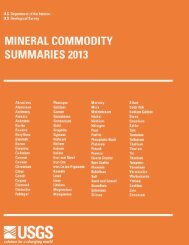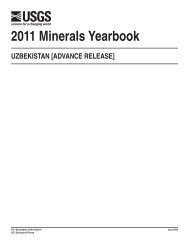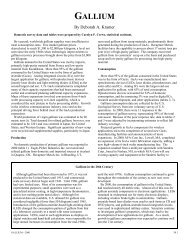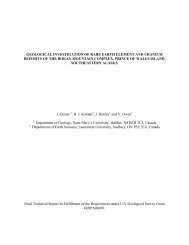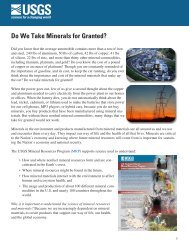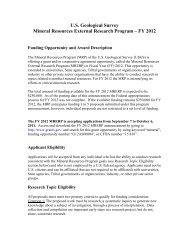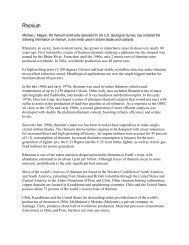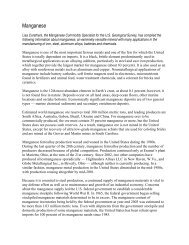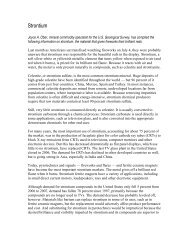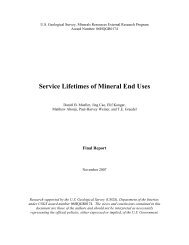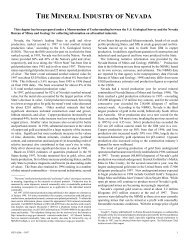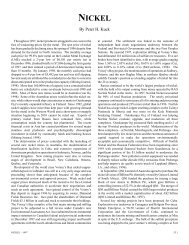Mineral Commodity Summaries 2003 - Mineral Resources Program ...
Mineral Commodity Summaries 2003 - Mineral Resources Program ...
Mineral Commodity Summaries 2003 - Mineral Resources Program ...
Create successful ePaper yourself
Turn your PDF publications into a flip-book with our unique Google optimized e-Paper software.
TELLURIUM<br />
Events, Trends, and Issues: Domestic and world tellurium demand decreased slightly in 2002. World production of<br />
tellurium, a byproduct of copper refining, was down slightly owing to a drop in the level of copper production. Detailed<br />
information on the world tellurium market was not available.<br />
Cadmium telluride is one of the most promising thin-film photovoltaic module compounds for power generation,<br />
achieving some of the highest power conversion ratios yet obtained. A possible application of this technology that<br />
would significantly affect tellurium demand is for power supplies in remote areas, mainly in developing countries,<br />
where the largest percentage increases in power consumption are expected to occur early in this century.<br />
Tellurium is used in a germanium-antimony-tellurium alloy for optical storage in digital video discs. This is a rapidly<br />
growing market, but the amount of tellurium used for each disc is very small.<br />
World Refinery Production, Reserves, and Reserve Base: Reserves and reserve base estimates for Peru have<br />
been increased based on new information from that country.<br />
Refinery production Reserves 5<br />
Reserve base 5<br />
2001 2002 e<br />
United States W W 3,000 6,000<br />
Canada 80 75 650 1,500<br />
Japan 39 39 — —<br />
Peru 22 20 1,600 2,800<br />
Other countries 6<br />
NA NA 16,000 37,000<br />
World total (may be rounded)<br />
7<br />
141<br />
7<br />
130 21,000 47,000<br />
World <strong>Resources</strong>: The figures shown for reserves and reserve base include only tellurium contained in economic<br />
copper deposits. In addition to copper deposits, significant quantities of tellurium are contained in gold and lead<br />
deposits, but currently none is recovered. Deposits of coal, copper, and other metals that are of subeconomic grade<br />
contain several times the amount of tellurium contained in identified economic copper deposits. However, it is unlikely<br />
that tellurium contained in these deposits can be recovered economically.<br />
Substitutes: The chief substitutes for tellurium are selenium, bismuth, and lead in metallurgical applications;<br />
selenium and sulfur in rubber compound applications; and selenium, germanium, and organic compounds in electronic<br />
applications.<br />
e<br />
Estimated. NA Not available. W Withheld to avoid disclosing company proprietary data. — Zero.<br />
1<br />
Prepared by Henry E. Hilliard.<br />
2<br />
Imports of boron and tellurium are grouped together under the Harmonized Tariff Schedule; however, imports of boron are thought to be small<br />
relative to tellurium.<br />
3<br />
Yearend prices quoted by the sole producer.<br />
4<br />
Defined as imports - exports + adjustments for Government and industry stock changes.<br />
5<br />
See Appendix C for definitions. Estimates include tellurium contained in copper resources only.<br />
6<br />
In addition to the countries listed, Australia, Belgium, China, France, Germany, Kazakhstan, the Philippines, Russia, and the United Kingdom<br />
produce refined tellurium, but output is not reported and available information is inadequate for formulation of reliable production estimates.<br />
7<br />
Excludes refinery production from the United States.<br />
171<br />
U.S. Geological Survey, <strong>Mineral</strong> <strong>Commodity</strong> <strong>Summaries</strong>, January <strong>2003</strong>



